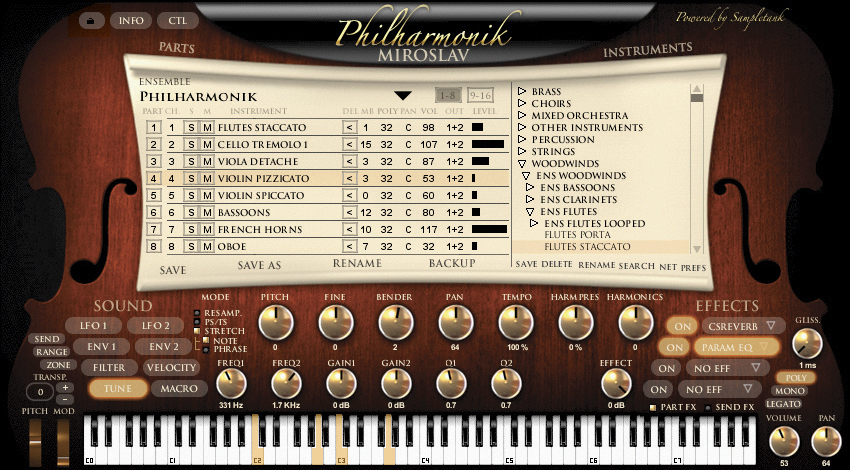UPDATE January 2016. Miroslav Philharmonik version 2 was released in December 2015. Based on the SampleTank 3 engine, the user interface is a thousand times better than the version reviewed below. I can actually use it without having to pull out the magnifer. There are new sounds and key-switching instruments are also provided. The instruments from Philharmonik 1 are also included in this program. The product is 64-bit. The mixing tab of the interface makes it possible to mix ‘in the instrument’ rather than having to mix everything in your DAW. If time permits I may do a full review. As to the Kontakt vs. Miroslav comments below, if you are into just orchestral music and don’t need to do sampling and creating your own instruments, pick Miroslav first, then Kontakt, although some of the add-on libraries available for Kontakt offer sounds and features not found in Miroslav, especially if you are involved in film or game music.
An older product, but it sounds just fine
This product, from IK Multimedia, is an older product that has been on the market for at least 4 years. But, I’ve only just now (Nov 2012) had a chance to use it. You could call it a classic. If you’re just getting into sound libraries and doing recordings or composing on a computer, this is a good library.
What is it? It is a sound library consisting of all the instruments in a typical classical orchestra. There around 8 Gigabytes of samples. There are various articulations of the different instruments, as applicable. For example, there is flutter tongue for the flute, pizzicato for the strings, legato and stacc. for all the instruments.
There are individual sounds for all the instruments in the woodwinds, brass, string and percussion families as well as some keyboard and harp sounds, including some nice organ sounds. In addition to the single patches, it comes with numerous presets that layer various instruments from different families. If that weren’t enough, there are single patches that contain a mixture of instruments. I believe there are over 3,000 presets.
The instruments are accessed via a stand-alone program or via VST, AU and I believe a few other plugin formats that I don’t use. There are 16 channels/slots that you can load instruments into. Each slot can be assigned to any channel and panning and volume can be set. There are combination presets that can save you the time of loading instruments on each track. Use your MIDI keyboard to play it (or use the mouse and play the on-screen keyboard or some of the keys on your computer keyboard work).
I use mainly the Kontakt factory library for my orchestral needs so that’s all I have to go on for a comparison. The big difference is that there seems to be more instruments and articulations and types of instruments in the Miroslav package. Unlike Kontakt, that uses key switching to switch between, say pizz. and legato, this uses separate patches. That can take a little getting use to. I do also use Session Strings Pro. I find the Miroslav to be a better sound overall than what I can get from Kontakt, but that’s not to say Kontakt isn’t good, just Miroslav better so far as the sound & variety of orchestra instruments. If I could only choose between Kontakt and Miroslav Philharmonik, Kontakt would win, but if you’re heavy into orchestral sounds, you might make the opposite choice. .
There are quite a bit of ways to modify the individual sounds. These include LFO’s, Envelopes, filters, velocity adjustments, keyboard range, many effects and effect sends, both individually and globally.
Sibelius and Windows 7 64-bit users.
If you are using the Windows 7, 64-bit version of Sibelius, you will not be able to use the plugin, at least not with the 64-bit version of Sibelius. Fortunately, Sibelius 7 installs both the 64-bit and 32-bit versions. Go to the start menu and select the 32-bit version of Sibelius. As mentioned before, Miroslav is an older program, so it hasn’t been updated to 64-bit yet.
Reaper users.
I’ve found the product to be stable and fine for use in Reaper, Win 7 64-bit version. Just be sure to set your midi controller to the correct channel, set the Reaper input to the controller AND arm the channel for recording.
Criticism.
The interface is very hard to see. The image above was downloaded from the IK Multimedia site. That image looks better than the actual program does. I’m using a 1920×1080 display and I can barely read the text. If I use the Windows magnifier to zoom in 200% it seems obvious that the graphics are not very hi-res. This makes it hard to learn the program. However, once you get use to it, it’s not a bad interface. It would have been nice if the manual told more about the presets, like which ones make extensive use of the mod wheel, expression control or other controllers. As with most any sound library I’ve ever used, the manuals barely cover the minimum and offer little in the way of practical usage. It’s sort of a ‘here are the sounds and how to load them, now you’re on your own.’ More tutorials and tips would be most welcome. Since it is an older program, it doesn’t support WASAPI sound support. I’d like to see it updated to a 64-bit plugin and the graphics improved.
Since I’m new to it, did I miss anything or do you have any comments about it?


2 replies on “Miroslav Philharmonik Review”
Reblogged this on duART Studio Blog.
Thanks for the repost